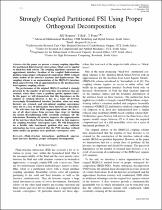JavaScript is disabled for your browser. Some features of this site may not work without it.
- ResearchSpace
- →
- Research Publications/Outputs
- →
- Conference Publications
- →
- View Item
| dc.contributor.author |
Bogaers, Alfred EJ

|
|
| dc.contributor.author |
Kok, S

|
|
| dc.contributor.author |
Franz, T

|
|
| dc.date.accessioned | 2013-03-25T06:50:50Z | |
| dc.date.available | 2013-03-25T06:50:50Z | |
| dc.date.issued | 2012-12 | |
| dc.identifier.citation | Bogaers, AEJ, Kok, S and Franz, T. 2012. Strongly coupled partitioned FSI using proper orthogonal decomposition. In: 8th South African Conference on Computational and Applied Mechanics (SACAM 2012), Johannesburg, South Africa, 3-5 September 2012 | en_US |
| dc.identifier.uri | http://hdl.handle.net/10204/6608 | |
| dc.description | 8th South African Conference on Computational and Applied Mechanics (SACAM 2012), Johannesburg, South Africa, 3-5 September 2012 | en_US |
| dc.description.abstract | In this paper we present a strong coupling algorithm for partitioned fluid-structure interactions which can be applied to black-box field solvers. The coupling algorithm constructs an approximate interface Jacobian of the coupled fluid-structure problem using proper orthogonal decomposition (POD) reduced order models of the interface tractions and displacements. The coupling scheme is an augmentation of the IBQN-LS (interface block-quasi-Newton with an approximation for the Jacobian from least-squares) coupling scheme. The performance of the original IBQN-LS method is strongly governed by the number of previous time step histories that are retained, where there exists a problem specific optimal choice. In this paper we will demonstrate that this dependence on the number of retained histories is due to a trade-off between increasingly ill-conditioned interface Jacobian, when too many histories are retained and sub-optimal coupling convergence rates due to a loss of information when histories are discarded. We will show that the POD augmentation allows for the reuse of all observations from previous time steps by limiting the matrix ill-conditioning while essentially retaining ‘all’ the information. Retaining all histories improves the approximation of the interface block-Newton Jacobian, which in turn improves the coupling iterations’ convergence rates. We will demonstrate on a flexible tube benchmark problem that once sufficient information has been captured that the POD interface reduced order model can produce near quadratic convergence rates. | en_US |
| dc.language.iso | en | en_US |
| dc.publisher | SAAM | en_US |
| dc.relation.ispartofseries | Workflow;10448 | |
| dc.subject | Fluid-structure interactions | en_US |
| dc.subject | Partitioned | en_US |
| dc.subject | Approximate interface Jacobian | en_US |
| dc.subject | Proper orthogonal decomposition | en_US |
| dc.title | Strongly coupled partitioned FSI using proper orthogonal decomposition | en_US |
| dc.type | Conference Presentation | en_US |
| dc.identifier.apacitation | Bogaers, A. E., Kok, S., & Franz, T. (2012). Strongly coupled partitioned FSI using proper orthogonal decomposition. SAAM. http://hdl.handle.net/10204/6608 | en_ZA |
| dc.identifier.chicagocitation | Bogaers, Alfred EJ, S Kok, and T Franz. "Strongly coupled partitioned FSI using proper orthogonal decomposition." (2012): http://hdl.handle.net/10204/6608 | en_ZA |
| dc.identifier.vancouvercitation | Bogaers AE, Kok S, Franz T, Strongly coupled partitioned FSI using proper orthogonal decomposition; SAAM; 2012. http://hdl.handle.net/10204/6608 . | en_ZA |
| dc.identifier.ris | TY - Conference Presentation AU - Bogaers, Alfred EJ AU - Kok, S AU - Franz, T AB - In this paper we present a strong coupling algorithm for partitioned fluid-structure interactions which can be applied to black-box field solvers. The coupling algorithm constructs an approximate interface Jacobian of the coupled fluid-structure problem using proper orthogonal decomposition (POD) reduced order models of the interface tractions and displacements. The coupling scheme is an augmentation of the IBQN-LS (interface block-quasi-Newton with an approximation for the Jacobian from least-squares) coupling scheme. The performance of the original IBQN-LS method is strongly governed by the number of previous time step histories that are retained, where there exists a problem specific optimal choice. In this paper we will demonstrate that this dependence on the number of retained histories is due to a trade-off between increasingly ill-conditioned interface Jacobian, when too many histories are retained and sub-optimal coupling convergence rates due to a loss of information when histories are discarded. We will show that the POD augmentation allows for the reuse of all observations from previous time steps by limiting the matrix ill-conditioning while essentially retaining ‘all’ the information. Retaining all histories improves the approximation of the interface block-Newton Jacobian, which in turn improves the coupling iterations’ convergence rates. We will demonstrate on a flexible tube benchmark problem that once sufficient information has been captured that the POD interface reduced order model can produce near quadratic convergence rates. DA - 2012-12 DB - ResearchSpace DP - CSIR KW - Fluid-structure interactions KW - Partitioned KW - Approximate interface Jacobian KW - Proper orthogonal decomposition LK - https://researchspace.csir.co.za PY - 2012 T1 - Strongly coupled partitioned FSI using proper orthogonal decomposition TI - Strongly coupled partitioned FSI using proper orthogonal decomposition UR - http://hdl.handle.net/10204/6608 ER - | en_ZA |






